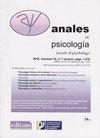是质量问题,是冗余问题,还是模型不足?判断高歧视项目适当性的一些策略
IF 1.3
4区 心理学
Q3 PSYCHOLOGY
引用次数: 0
摘要
在制定新的问卷时,传统上认为这些项目应尽可能具有歧视性,就好像这总是表明它们的质量一样。然而,在某些情况下,这些高度歧视可能掩盖了一些问题,如冗余、共享剩余、有偏见的分配或可能导致歧视估计膨胀的模型限制。因此,检查这些指数可能会导致错误地决定保留或删除哪些项目。为了说明这个问题,描述了两种具有实际数据的不同场景。第一个重点是一份问卷,其中包含一个明显具有高度歧视性但冗余的项目。第二个重点是对社区样本进行的临床问卷调查,这导致了高度正确的项目反应分布和夸大的歧视指数,尽管这些项目在大多数参与者中没有得到很好的歧视。我们提出了一些策略和检查来识别这些情况,以便可以识别和删除不合适的项目。因此,这篇文章旨在促进一种批评态度,这可能涉及在不适当的情况下违背既定原则。当开发新的问卷时,传统上认为项目必须尽可能具有歧视性,就好像这总是表明其质量一样。但在某些情况下,这些高歧视可能掩盖了一些问题,如冗余、共享剩余、有偏见的分布或模型限制,这些问题可能会导致对歧视的估计膨胀。因此,检查这些指数可能会导致对保留或删除哪些项目的错误决定。为了说明这个问题,用实际数据描述了两种不同的情况。第一个重点是一份问卷,其中包含一个看似非常歧视但多余的项目。第二个重点是对社区样本进行的临床问卷调查,这导致了非常有偏见的项目的反应分布和夸大的歧视指数,尽管这些项目在大多数受试者中没有很好的歧视。我们提出了一些策略和检查来识别这些情况,以促进识别和删除不合适的项目。因此,本文旨在促进批评态度,这可能意味着在不适当的情况下违反既定的常规原则。本文章由计算机程序翻译,如有差异,请以英文原文为准。
Is it quality, is it redundancy, or is model inadequacy? Some strategies for judging the appropriateness of high-discrimination items
When developing new questionnaires, it is traditionally assumed that the items should be as discriminative as possible, as if this was always indicative of their quality. However, in some cases these high discriminations may be masking some problems such as redundancies, shared residuals, biased distributions, or model limitations which may contribute to inflate the discrimination estimates. Therefore, the inspection of these indices may lead to erroneous decisions about which items to keep or eliminate. To illustrate this problem, two different scenarios with real data are described. The first focuses on a questionnaire that contains an item apparently highly discriminant, but redundant. The second focuses on a clinical questionnaire administered to a community sample, which gives place to highly right-skewed item response distributions and inflated discriminant indices, despite the items do not discriminate well among the majority of participants. We propose some strategies and checks to identify these situations, so that the items that are inappropriate may be identified and removed. Therefore, this article seeks to promote a critical attitude, which may involve going against routine stablished principles when they are not appropriate.
Cuando se desarrollan nuevos cuestionarios, tradicionalmente se asume que los ítems deben ser lo más discriminativos posible, como si esto fuera siempre indicativo de su calidad. Pero en algunos casos estas discriminaciones elevadas pueden estar ocultando algunos problemas como redundancias, residuales compartidos, distribuciones sesgadas o limitaciones del modelo que pueden contribuir a inflar las estimaciones de la discriminación. Por lo tanto, la inspección de estos índices puede llevar a decisiones erróneas sobre qué ítems mantener o eliminar. Para ilustrar este problema, se describen dos escenarios diferentes con datos reales. El primero se centra en un cuestionario que contiene un ítem aparentemente muy discriminante, pero redundante. El segundo se centra en un cuestionario clínico administrado a una muestra comunitaria, lo que da lugar a distribuciones de respuesta de los ítems muy sesgadas y a índices de discriminación inflados, a pesar de que los ítems no discriminan bien entre la mayoría de los sujetos. Proponemos algunas estrategias y comprobaciones para identificar estas situaciones, para facilitar la identificación y eliminación de los ítems inapropiados. Por lo tanto, este artículo pretende promover una actitud crítica, que puede implicar ir en contra de los principios rutinarios establecidos cuando no son apropiados.
求助全文
通过发布文献求助,成功后即可免费获取论文全文。
去求助
来源期刊

Anales De Psicologia
医学-心理学
CiteScore
3.30
自引率
5.90%
发文量
57
审稿时长
4-8 weeks
期刊介绍:
Anales de Psicologia / Annals of Psychology is a multidisciplinary journal of the various thematic areas of scientific psychology. It publishes original research articles and theoretical review in any of its basic, applied and methodological areas included within psychology.
Publishing, financing, marketing and distribution corresponds Editum: Editions of the University of Murcia (Spain). The organizational guidelines and editorial policies come from the Editorial Team (elected for four years by the Areas and / or Departments of Psychology at the University of Murcia) and the Editorial Board, composed of scholars and experts from different universities and institutions national and international. It is published in print (ISSN: 0212-9728) since 1984 and in Internet publishing (web) (ISSN: 1695-2294) since 2000. Available online full text in pdf from the vol. 1 1984.
Anales de Psicologia / Annals of Psychology maintains a system of exchange with other journals and publications of psychology in the world. Through an free exchange agreement with their respective publishers or entities responsible for editing, these journals and publications are received at the University of Murcia (Biblioteca "Luis Vives", near the Faculty of Psychology) and in return, our journal is sent to libraries and educational and research institutions such centers responsible for editing.
 求助内容:
求助内容: 应助结果提醒方式:
应助结果提醒方式:


